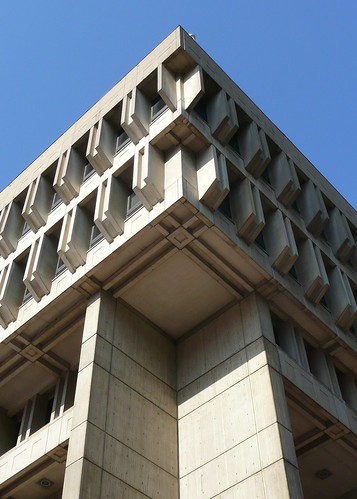 |
| Untitled, Larry Poons, 1960s. (image credit) |
"Larry Poon's ovals, while strongly suggesting an undiscovered, perhaps musical symmetry, refuse to rely on such symettry. Instead they leap accross the surface. The eye jumps from one oval to the next, as the eye jumps from detail to detail in a Mannerist facade...the purist philosophy of absolute "rightness" is already breaking down."Hutchinson unleashes an onslaught of Mannerist reaction to Minimalist Art:
"Anuszkiewicz destroys the extreme classicality of his compositions simply by causing the eye to jolt back and forth...Hinman's convoluted canvases have a curving diagonal space plunging out at the viewer, who must retreat...Ginnever's green and black sculpture appears voluminous. Seen from the side, it reveals itself as a superstructure, a false-front...Grosvenor's giant structures mock other giantist sculptures in a Mannerist way...Valledor's parallelograms lean forward, in a way mocking geometric stability yet retaining symettry...There is no end to the Mannerist love of reversal, double meaning and spoof."
 |
| Kazimir Malevich's refined and pure 'Black Square' (1913) paired with Dan Flavin's "dramatic hysterical" take on Minimal Art, 'the diagonal of May 25' (1963). |
The developer is quoted saying, "The only way it would function is to cut down all the trees" ... "It was placed there because that's the only spot where it could collect the rays of the sun and function appropriately."
The builder's wife contends, "I don't know how you do this to somebody. I just don't. We want to retire here. This is our retirement home. And then we have to be neighbors with someone who would do that, for the rest of our life? My question is why?"
Gonzosaint's colorful comments on the article importantly hint at the connections between the self-parody of the green design movement and a capitalist desire for greed à la green:
"Are we actually supposed to feel sorry for this "victim"? Only the enquirer could be this tone deaf. Today is the 10th anniversary of 9/11 and our local paper is "reporting" on the trials and tribulations of some rich strumpet having one of her 3 views obstructed by her even richer neighbor's solar panels. Of course there is no mention of the poor people whose neighborhood was eminent domained and subsequently razed to make room for these monuments to American excess. My only regret is that her neighbor's solar panels aren't in the shape of an extended middle finger."The essence of the slippery nature of Mannerist Green Design is called out by Tara Dodrill, of the Yahoo! Contributor Network : "Is Neyer [the Developer] a rude neighbor or did he simply place the solar panels in the direct path of the sunshine to fuel his home?"
 |
| Green Design as idea (left) and reality (right). Right Image Credit: The Enquirer/Patrick Reddy. |
Mannerist Green Design might also take on the role of the Spite House, or the Spite Fence: a bending of the rules for selfish gain, yielding the architectural equivalent of the exclamation point. Numerous examples exist, from the Richardson Spite House in New York City of 1882 to Atelier Bow Wow's catalog of Pet Architecture in 2002. Mannerist Green Design might contribute to this tradition of building in spite of your neighbor. It will certainly challenge our evolving understanding of natural resource rights (i.e. the right to solar access, public vs. private rights to water, wind leases & easements, air rights, etc.).
 |
| Jan Pol's (b. 1894) "Monument to Injustice" (image credit) paired with 1m wide by 10m tall house in Madre de Deus, Brazil (image credit) |
"Contemporary Mannerist work sometimes gets so extreme in its use of acid color, exaggeration of shape, and in its drama that it appears hysterical. Indeed in today's reaction against Romanticism, against Freudian explanation, against pure logic, these artists see themselves as useless members in a society where everybody is useless. Where art was once the only useless thing, now everything has lost meaning. If the artist himself feels he is losing meaning, no wonder he reacts with hysteria. He does super works with the directionless energy of a hysteric - and the result is often hysteria's attendant paralysis. The coldness, the lack of motion, the acidity of color, the lack of detail (expression), are Mannerist symptoms felt before in other centuries in times of mounting disbelief. Bronzino's human contemporary view will break out into horizons broader than hitherto, views not seen entirely from the human scope. It would be a true Mannerist convention that works done despairingly, that desperately parody, should turn out to be truly significant.
The scientist offers a hopeful world, a world where inevitable progress discovers more and more, a world that gets better and better. This world is sane, stable, and knows where it is going. The Mannerist counters with a world in intellectual hysteria, punctuated by frozen activity, a world where space-time cease to have meaning, a world of soundless gestures, where humans do not live."




